Analysis of Risk Management: Culture, Attitude and Implementation
VerifiedAdded on 2023/01/17
|12
|2769
|70
Report
AI Summary
This report examines the critical aspects of risk management within organizations, focusing on the interplay between risk culture and risk attitude. It begins with a literature review defining risk culture as the behavioral and value system influencing employee and management decisions, and risk attitude as the individual's response to uncertainty. The report explores how risk attitude influences risk culture and vice versa, highlighting their interconnectedness and impact on organizational outcomes. It emphasizes the need for a strong risk culture within project teams, outlining the benefits such as asset protection, disaster prevention, and proactive adaptation to changes. The report also describes the characteristics of a good risk culture, including a risk-oriented vision, supportive leadership, employee engagement, data-driven decision-making, and future planning. The analysis underscores the importance of a positive risk attitude among employees, enabling them to perform their tasks effectively and contribute to organizational goals.
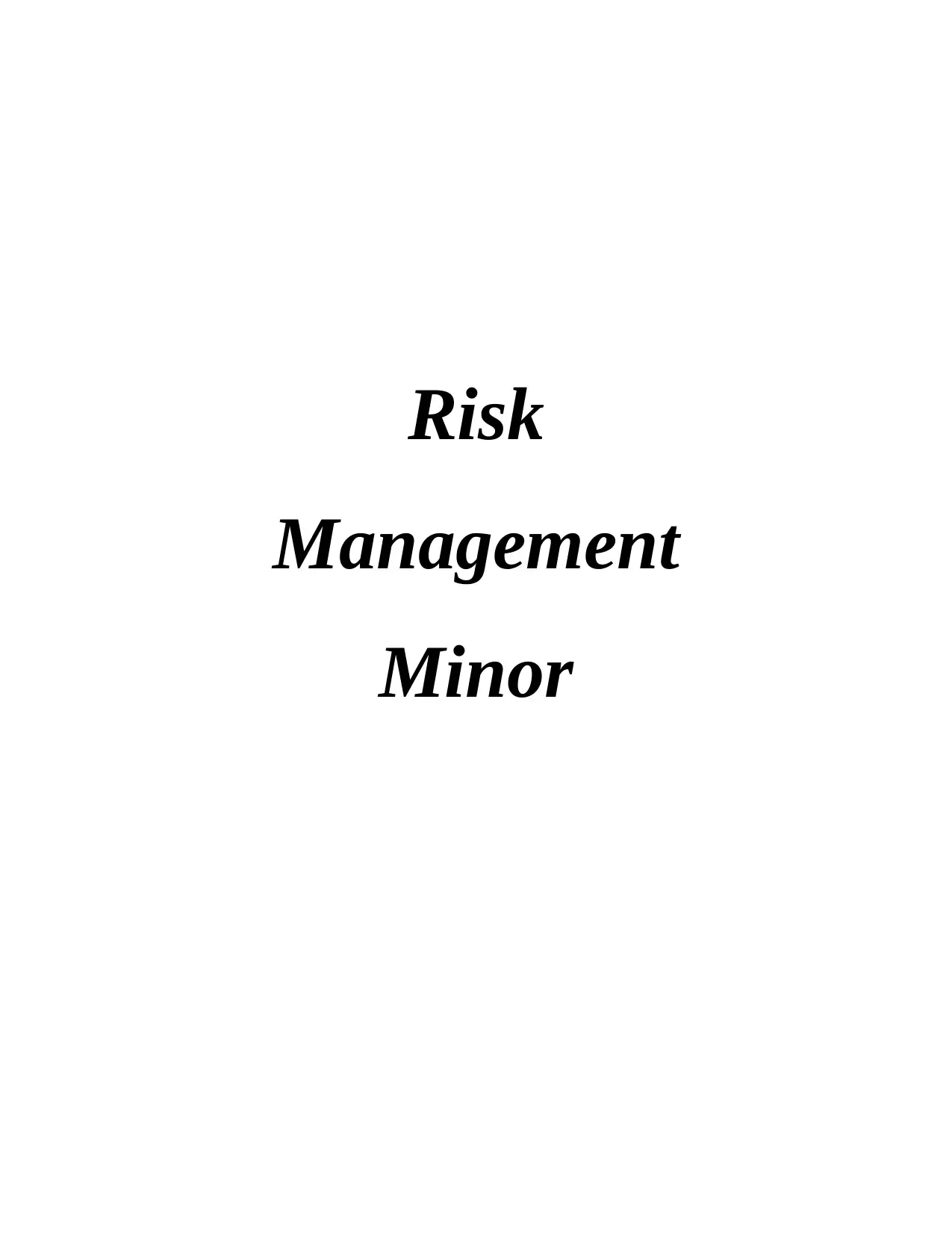
Risk
Management
Minor
Management
Minor
Paraphrase This Document
Need a fresh take? Get an instant paraphrase of this document with our AI Paraphraser
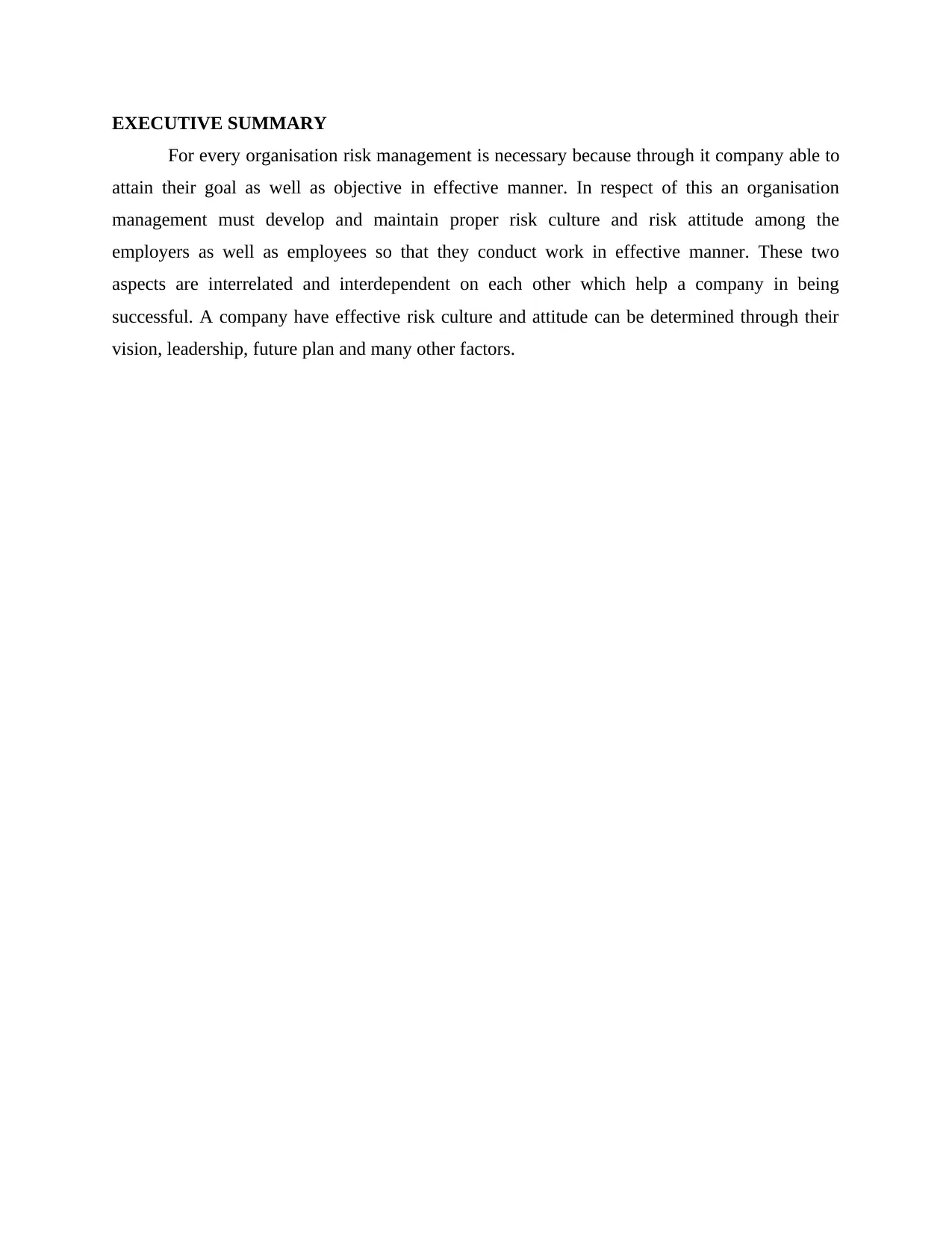
EXECUTIVE SUMMARY
For every organisation risk management is necessary because through it company able to
attain their goal as well as objective in effective manner. In respect of this an organisation
management must develop and maintain proper risk culture and risk attitude among the
employers as well as employees so that they conduct work in effective manner. These two
aspects are interrelated and interdependent on each other which help a company in being
successful. A company have effective risk culture and attitude can be determined through their
vision, leadership, future plan and many other factors.
For every organisation risk management is necessary because through it company able to
attain their goal as well as objective in effective manner. In respect of this an organisation
management must develop and maintain proper risk culture and risk attitude among the
employers as well as employees so that they conduct work in effective manner. These two
aspects are interrelated and interdependent on each other which help a company in being
successful. A company have effective risk culture and attitude can be determined through their
vision, leadership, future plan and many other factors.
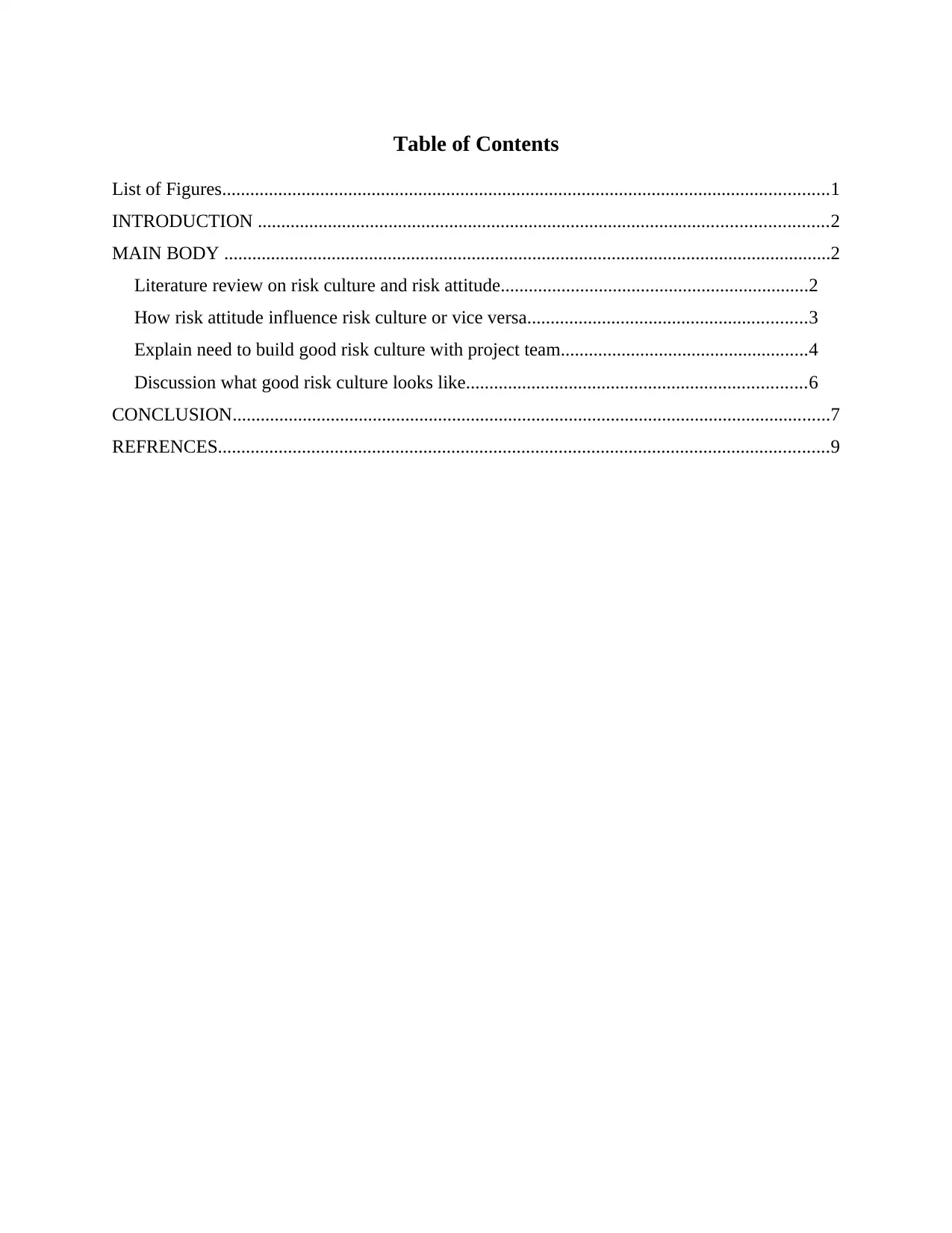
Table of Contents
List of Figures..................................................................................................................................1
INTRODUCTION ..........................................................................................................................2
MAIN BODY ..................................................................................................................................2
Literature review on risk culture and risk attitude..................................................................2
How risk attitude influence risk culture or vice versa............................................................3
Explain need to build good risk culture with project team.....................................................4
Discussion what good risk culture looks like.........................................................................6
CONCLUSION................................................................................................................................7
REFRENCES...................................................................................................................................9
List of Figures..................................................................................................................................1
INTRODUCTION ..........................................................................................................................2
MAIN BODY ..................................................................................................................................2
Literature review on risk culture and risk attitude..................................................................2
How risk attitude influence risk culture or vice versa............................................................3
Explain need to build good risk culture with project team.....................................................4
Discussion what good risk culture looks like.........................................................................6
CONCLUSION................................................................................................................................7
REFRENCES...................................................................................................................................9
⊘ This is a preview!⊘
Do you want full access?
Subscribe today to unlock all pages.

Trusted by 1+ million students worldwide

List of Figures
1st figure- ABC of risk culture
1
1st figure- ABC of risk culture
1
Paraphrase This Document
Need a fresh take? Get an instant paraphrase of this document with our AI Paraphraser
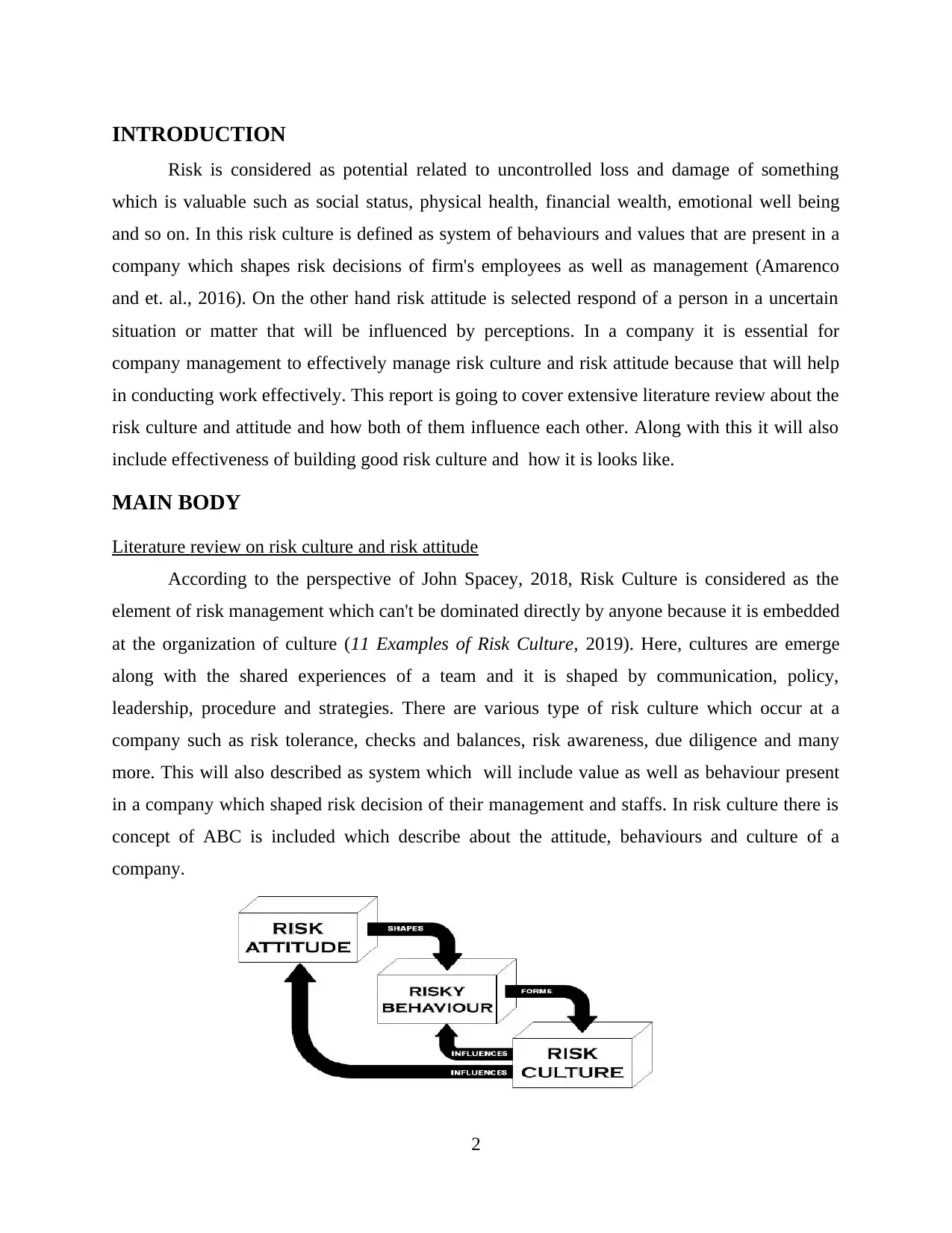
INTRODUCTION
Risk is considered as potential related to uncontrolled loss and damage of something
which is valuable such as social status, physical health, financial wealth, emotional well being
and so on. In this risk culture is defined as system of behaviours and values that are present in a
company which shapes risk decisions of firm's employees as well as management (Amarenco
and et. al., 2016). On the other hand risk attitude is selected respond of a person in a uncertain
situation or matter that will be influenced by perceptions. In a company it is essential for
company management to effectively manage risk culture and risk attitude because that will help
in conducting work effectively. This report is going to cover extensive literature review about the
risk culture and attitude and how both of them influence each other. Along with this it will also
include effectiveness of building good risk culture and how it is looks like.
MAIN BODY
Literature review on risk culture and risk attitude
According to the perspective of John Spacey, 2018, Risk Culture is considered as the
element of risk management which can't be dominated directly by anyone because it is embedded
at the organization of culture (11 Examples of Risk Culture, 2019). Here, cultures are emerge
along with the shared experiences of a team and it is shaped by communication, policy,
leadership, procedure and strategies. There are various type of risk culture which occur at a
company such as risk tolerance, checks and balances, risk awareness, due diligence and many
more. This will also described as system which will include value as well as behaviour present
in a company which shaped risk decision of their management and staffs. In risk culture there is
concept of ABC is included which describe about the attitude, behaviours and culture of a
company.
2
Risk is considered as potential related to uncontrolled loss and damage of something
which is valuable such as social status, physical health, financial wealth, emotional well being
and so on. In this risk culture is defined as system of behaviours and values that are present in a
company which shapes risk decisions of firm's employees as well as management (Amarenco
and et. al., 2016). On the other hand risk attitude is selected respond of a person in a uncertain
situation or matter that will be influenced by perceptions. In a company it is essential for
company management to effectively manage risk culture and risk attitude because that will help
in conducting work effectively. This report is going to cover extensive literature review about the
risk culture and attitude and how both of them influence each other. Along with this it will also
include effectiveness of building good risk culture and how it is looks like.
MAIN BODY
Literature review on risk culture and risk attitude
According to the perspective of John Spacey, 2018, Risk Culture is considered as the
element of risk management which can't be dominated directly by anyone because it is embedded
at the organization of culture (11 Examples of Risk Culture, 2019). Here, cultures are emerge
along with the shared experiences of a team and it is shaped by communication, policy,
leadership, procedure and strategies. There are various type of risk culture which occur at a
company such as risk tolerance, checks and balances, risk awareness, due diligence and many
more. This will also described as system which will include value as well as behaviour present
in a company which shaped risk decision of their management and staffs. In risk culture there is
concept of ABC is included which describe about the attitude, behaviours and culture of a
company.
2
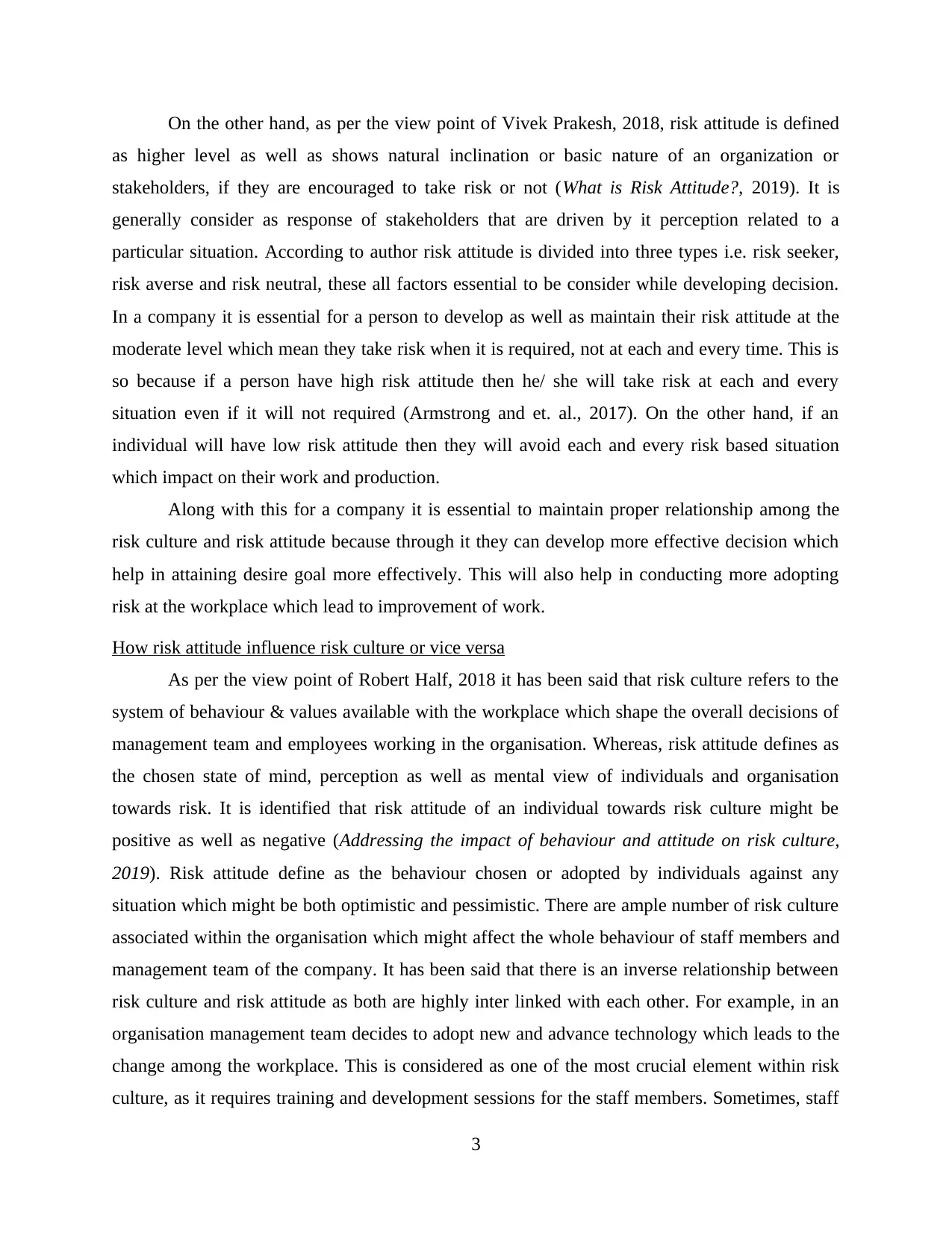
On the other hand, as per the view point of Vivek Prakesh, 2018, risk attitude is defined
as higher level as well as shows natural inclination or basic nature of an organization or
stakeholders, if they are encouraged to take risk or not (What is Risk Attitude?, 2019). It is
generally consider as response of stakeholders that are driven by it perception related to a
particular situation. According to author risk attitude is divided into three types i.e. risk seeker,
risk averse and risk neutral, these all factors essential to be consider while developing decision.
In a company it is essential for a person to develop as well as maintain their risk attitude at the
moderate level which mean they take risk when it is required, not at each and every time. This is
so because if a person have high risk attitude then he/ she will take risk at each and every
situation even if it will not required (Armstrong and et. al., 2017). On the other hand, if an
individual will have low risk attitude then they will avoid each and every risk based situation
which impact on their work and production.
Along with this for a company it is essential to maintain proper relationship among the
risk culture and risk attitude because through it they can develop more effective decision which
help in attaining desire goal more effectively. This will also help in conducting more adopting
risk at the workplace which lead to improvement of work.
How risk attitude influence risk culture or vice versa
As per the view point of Robert Half, 2018 it has been said that risk culture refers to the
system of behaviour & values available with the workplace which shape the overall decisions of
management team and employees working in the organisation. Whereas, risk attitude defines as
the chosen state of mind, perception as well as mental view of individuals and organisation
towards risk. It is identified that risk attitude of an individual towards risk culture might be
positive as well as negative (Addressing the impact of behaviour and attitude on risk culture,
2019). Risk attitude define as the behaviour chosen or adopted by individuals against any
situation which might be both optimistic and pessimistic. There are ample number of risk culture
associated within the organisation which might affect the whole behaviour of staff members and
management team of the company. It has been said that there is an inverse relationship between
risk culture and risk attitude as both are highly inter linked with each other. For example, in an
organisation management team decides to adopt new and advance technology which leads to the
change among the workplace. This is considered as one of the most crucial element within risk
culture, as it requires training and development sessions for the staff members. Sometimes, staff
3
as higher level as well as shows natural inclination or basic nature of an organization or
stakeholders, if they are encouraged to take risk or not (What is Risk Attitude?, 2019). It is
generally consider as response of stakeholders that are driven by it perception related to a
particular situation. According to author risk attitude is divided into three types i.e. risk seeker,
risk averse and risk neutral, these all factors essential to be consider while developing decision.
In a company it is essential for a person to develop as well as maintain their risk attitude at the
moderate level which mean they take risk when it is required, not at each and every time. This is
so because if a person have high risk attitude then he/ she will take risk at each and every
situation even if it will not required (Armstrong and et. al., 2017). On the other hand, if an
individual will have low risk attitude then they will avoid each and every risk based situation
which impact on their work and production.
Along with this for a company it is essential to maintain proper relationship among the
risk culture and risk attitude because through it they can develop more effective decision which
help in attaining desire goal more effectively. This will also help in conducting more adopting
risk at the workplace which lead to improvement of work.
How risk attitude influence risk culture or vice versa
As per the view point of Robert Half, 2018 it has been said that risk culture refers to the
system of behaviour & values available with the workplace which shape the overall decisions of
management team and employees working in the organisation. Whereas, risk attitude defines as
the chosen state of mind, perception as well as mental view of individuals and organisation
towards risk. It is identified that risk attitude of an individual towards risk culture might be
positive as well as negative (Addressing the impact of behaviour and attitude on risk culture,
2019). Risk attitude define as the behaviour chosen or adopted by individuals against any
situation which might be both optimistic and pessimistic. There are ample number of risk culture
associated within the organisation which might affect the whole behaviour of staff members and
management team of the company. It has been said that there is an inverse relationship between
risk culture and risk attitude as both are highly inter linked with each other. For example, in an
organisation management team decides to adopt new and advance technology which leads to the
change among the workplace. This is considered as one of the most crucial element within risk
culture, as it requires training and development sessions for the staff members. Sometimes, staff
3
⊘ This is a preview!⊘
Do you want full access?
Subscribe today to unlock all pages.

Trusted by 1+ million students worldwide
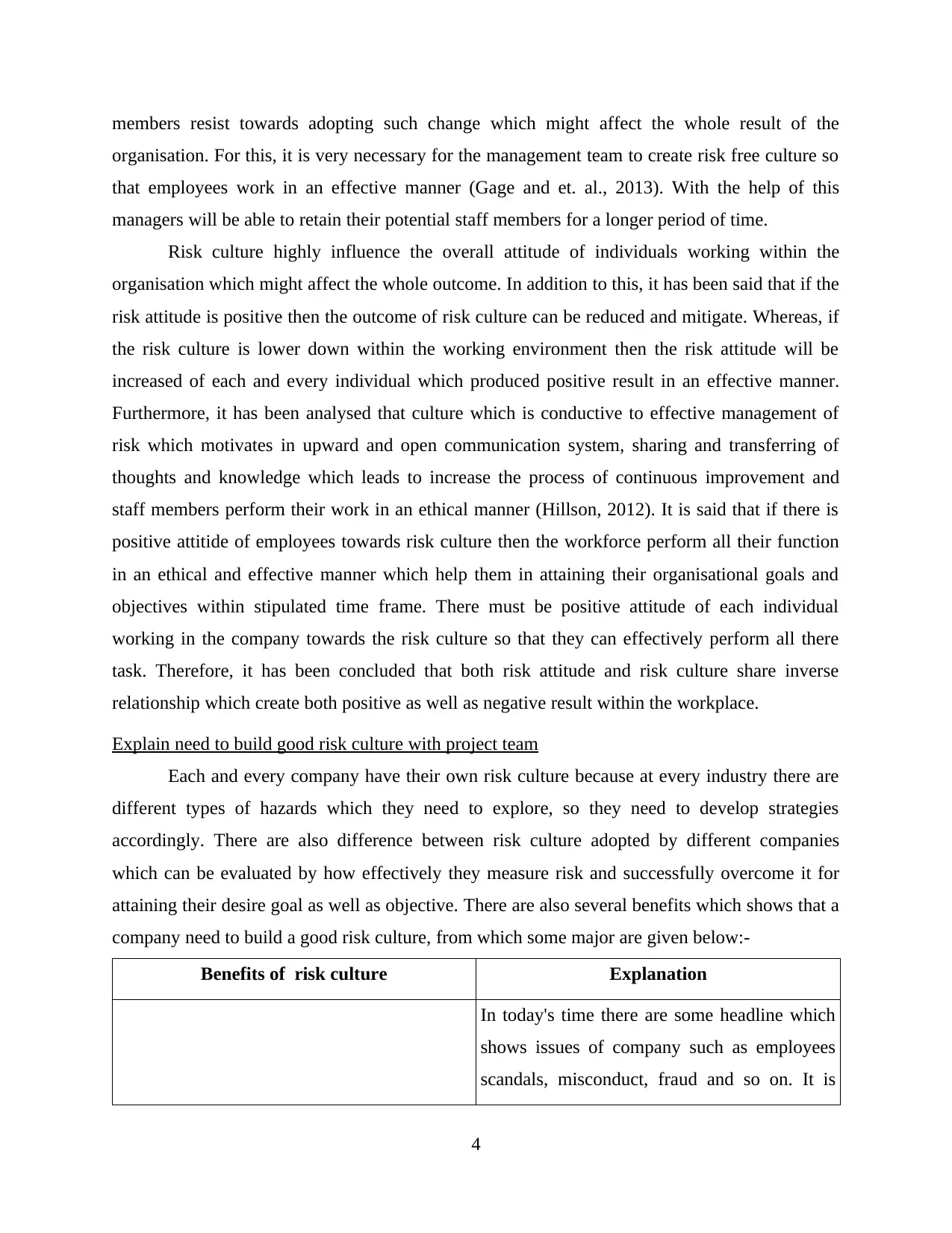
members resist towards adopting such change which might affect the whole result of the
organisation. For this, it is very necessary for the management team to create risk free culture so
that employees work in an effective manner (Gage and et. al., 2013). With the help of this
managers will be able to retain their potential staff members for a longer period of time.
Risk culture highly influence the overall attitude of individuals working within the
organisation which might affect the whole outcome. In addition to this, it has been said that if the
risk attitude is positive then the outcome of risk culture can be reduced and mitigate. Whereas, if
the risk culture is lower down within the working environment then the risk attitude will be
increased of each and every individual which produced positive result in an effective manner.
Furthermore, it has been analysed that culture which is conductive to effective management of
risk which motivates in upward and open communication system, sharing and transferring of
thoughts and knowledge which leads to increase the process of continuous improvement and
staff members perform their work in an ethical manner (Hillson, 2012). It is said that if there is
positive attitide of employees towards risk culture then the workforce perform all their function
in an ethical and effective manner which help them in attaining their organisational goals and
objectives within stipulated time frame. There must be positive attitude of each individual
working in the company towards the risk culture so that they can effectively perform all there
task. Therefore, it has been concluded that both risk attitude and risk culture share inverse
relationship which create both positive as well as negative result within the workplace.
Explain need to build good risk culture with project team
Each and every company have their own risk culture because at every industry there are
different types of hazards which they need to explore, so they need to develop strategies
accordingly. There are also difference between risk culture adopted by different companies
which can be evaluated by how effectively they measure risk and successfully overcome it for
attaining their desire goal as well as objective. There are also several benefits which shows that a
company need to build a good risk culture, from which some major are given below:-
Benefits of risk culture Explanation
In today's time there are some headline which
shows issues of company such as employees
scandals, misconduct, fraud and so on. It is
4
organisation. For this, it is very necessary for the management team to create risk free culture so
that employees work in an effective manner (Gage and et. al., 2013). With the help of this
managers will be able to retain their potential staff members for a longer period of time.
Risk culture highly influence the overall attitude of individuals working within the
organisation which might affect the whole outcome. In addition to this, it has been said that if the
risk attitude is positive then the outcome of risk culture can be reduced and mitigate. Whereas, if
the risk culture is lower down within the working environment then the risk attitude will be
increased of each and every individual which produced positive result in an effective manner.
Furthermore, it has been analysed that culture which is conductive to effective management of
risk which motivates in upward and open communication system, sharing and transferring of
thoughts and knowledge which leads to increase the process of continuous improvement and
staff members perform their work in an ethical manner (Hillson, 2012). It is said that if there is
positive attitide of employees towards risk culture then the workforce perform all their function
in an ethical and effective manner which help them in attaining their organisational goals and
objectives within stipulated time frame. There must be positive attitude of each individual
working in the company towards the risk culture so that they can effectively perform all there
task. Therefore, it has been concluded that both risk attitude and risk culture share inverse
relationship which create both positive as well as negative result within the workplace.
Explain need to build good risk culture with project team
Each and every company have their own risk culture because at every industry there are
different types of hazards which they need to explore, so they need to develop strategies
accordingly. There are also difference between risk culture adopted by different companies
which can be evaluated by how effectively they measure risk and successfully overcome it for
attaining their desire goal as well as objective. There are also several benefits which shows that a
company need to build a good risk culture, from which some major are given below:-
Benefits of risk culture Explanation
In today's time there are some headline which
shows issues of company such as employees
scandals, misconduct, fraud and so on. It is
4
Paraphrase This Document
Need a fresh take? Get an instant paraphrase of this document with our AI Paraphraser
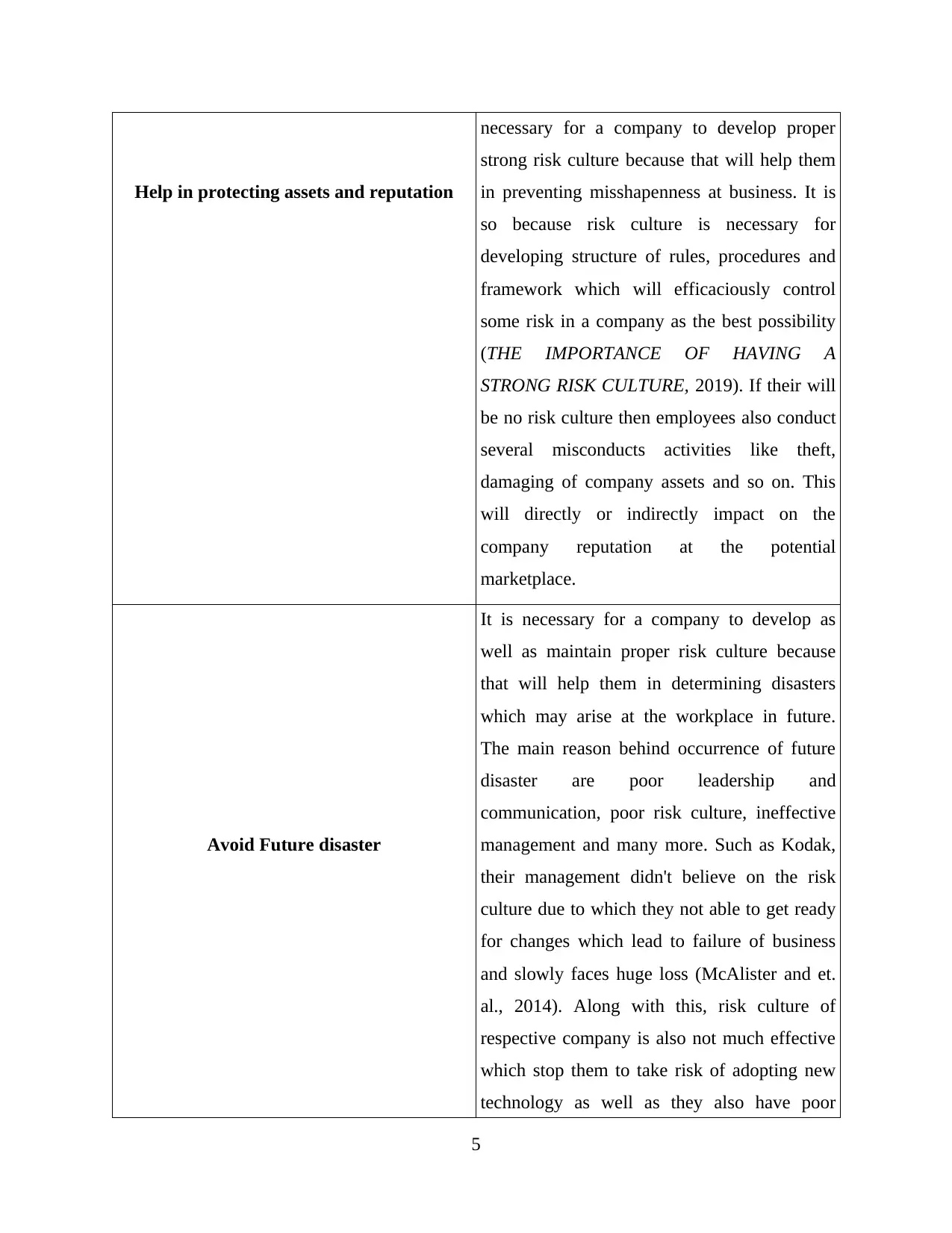
Help in protecting assets and reputation
necessary for a company to develop proper
strong risk culture because that will help them
in preventing misshapenness at business. It is
so because risk culture is necessary for
developing structure of rules, procedures and
framework which will efficaciously control
some risk in a company as the best possibility
(THE IMPORTANCE OF HAVING A
STRONG RISK CULTURE, 2019). If their will
be no risk culture then employees also conduct
several misconducts activities like theft,
damaging of company assets and so on. This
will directly or indirectly impact on the
company reputation at the potential
marketplace.
Avoid Future disaster
It is necessary for a company to develop as
well as maintain proper risk culture because
that will help them in determining disasters
which may arise at the workplace in future.
The main reason behind occurrence of future
disaster are poor leadership and
communication, poor risk culture, ineffective
management and many more. Such as Kodak,
their management didn't believe on the risk
culture due to which they not able to get ready
for changes which lead to failure of business
and slowly faces huge loss (McAlister and et.
al., 2014). Along with this, risk culture of
respective company is also not much effective
which stop them to take risk of adopting new
technology as well as they also have poor
5
necessary for a company to develop proper
strong risk culture because that will help them
in preventing misshapenness at business. It is
so because risk culture is necessary for
developing structure of rules, procedures and
framework which will efficaciously control
some risk in a company as the best possibility
(THE IMPORTANCE OF HAVING A
STRONG RISK CULTURE, 2019). If their will
be no risk culture then employees also conduct
several misconducts activities like theft,
damaging of company assets and so on. This
will directly or indirectly impact on the
company reputation at the potential
marketplace.
Avoid Future disaster
It is necessary for a company to develop as
well as maintain proper risk culture because
that will help them in determining disasters
which may arise at the workplace in future.
The main reason behind occurrence of future
disaster are poor leadership and
communication, poor risk culture, ineffective
management and many more. Such as Kodak,
their management didn't believe on the risk
culture due to which they not able to get ready
for changes which lead to failure of business
and slowly faces huge loss (McAlister and et.
al., 2014). Along with this, risk culture of
respective company is also not much effective
which stop them to take risk of adopting new
technology as well as they also have poor
5
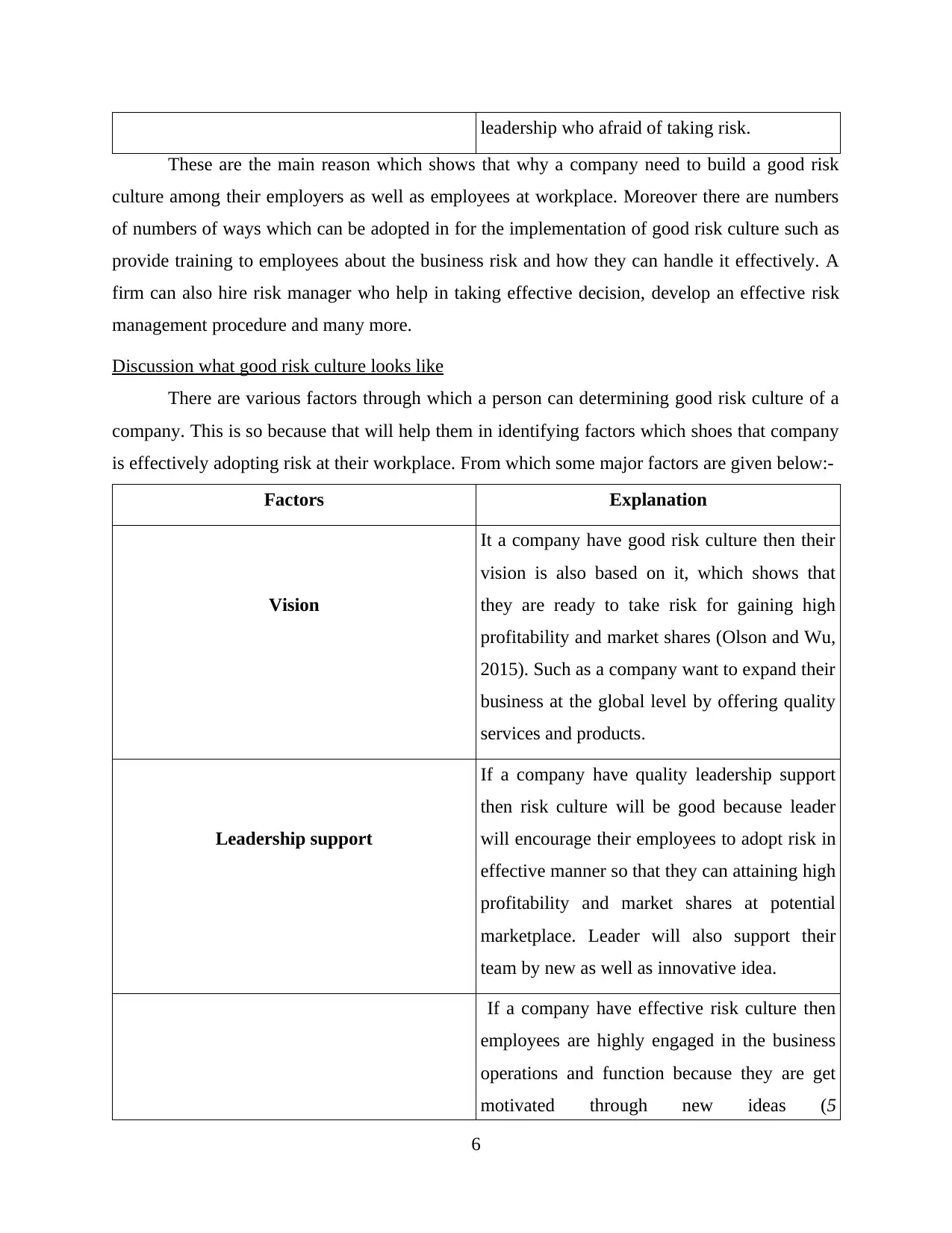
leadership who afraid of taking risk.
These are the main reason which shows that why a company need to build a good risk
culture among their employers as well as employees at workplace. Moreover there are numbers
of numbers of ways which can be adopted in for the implementation of good risk culture such as
provide training to employees about the business risk and how they can handle it effectively. A
firm can also hire risk manager who help in taking effective decision, develop an effective risk
management procedure and many more.
Discussion what good risk culture looks like
There are various factors through which a person can determining good risk culture of a
company. This is so because that will help them in identifying factors which shoes that company
is effectively adopting risk at their workplace. From which some major factors are given below:-
Factors Explanation
Vision
It a company have good risk culture then their
vision is also based on it, which shows that
they are ready to take risk for gaining high
profitability and market shares (Olson and Wu,
2015). Such as a company want to expand their
business at the global level by offering quality
services and products.
Leadership support
If a company have quality leadership support
then risk culture will be good because leader
will encourage their employees to adopt risk in
effective manner so that they can attaining high
profitability and market shares at potential
marketplace. Leader will also support their
team by new as well as innovative idea.
If a company have effective risk culture then
employees are highly engaged in the business
operations and function because they are get
motivated through new ideas (5
6
These are the main reason which shows that why a company need to build a good risk
culture among their employers as well as employees at workplace. Moreover there are numbers
of numbers of ways which can be adopted in for the implementation of good risk culture such as
provide training to employees about the business risk and how they can handle it effectively. A
firm can also hire risk manager who help in taking effective decision, develop an effective risk
management procedure and many more.
Discussion what good risk culture looks like
There are various factors through which a person can determining good risk culture of a
company. This is so because that will help them in identifying factors which shoes that company
is effectively adopting risk at their workplace. From which some major factors are given below:-
Factors Explanation
Vision
It a company have good risk culture then their
vision is also based on it, which shows that
they are ready to take risk for gaining high
profitability and market shares (Olson and Wu,
2015). Such as a company want to expand their
business at the global level by offering quality
services and products.
Leadership support
If a company have quality leadership support
then risk culture will be good because leader
will encourage their employees to adopt risk in
effective manner so that they can attaining high
profitability and market shares at potential
marketplace. Leader will also support their
team by new as well as innovative idea.
If a company have effective risk culture then
employees are highly engaged in the business
operations and function because they are get
motivated through new ideas (5
6
⊘ This is a preview!⊘
Do you want full access?
Subscribe today to unlock all pages.

Trusted by 1+ million students worldwide
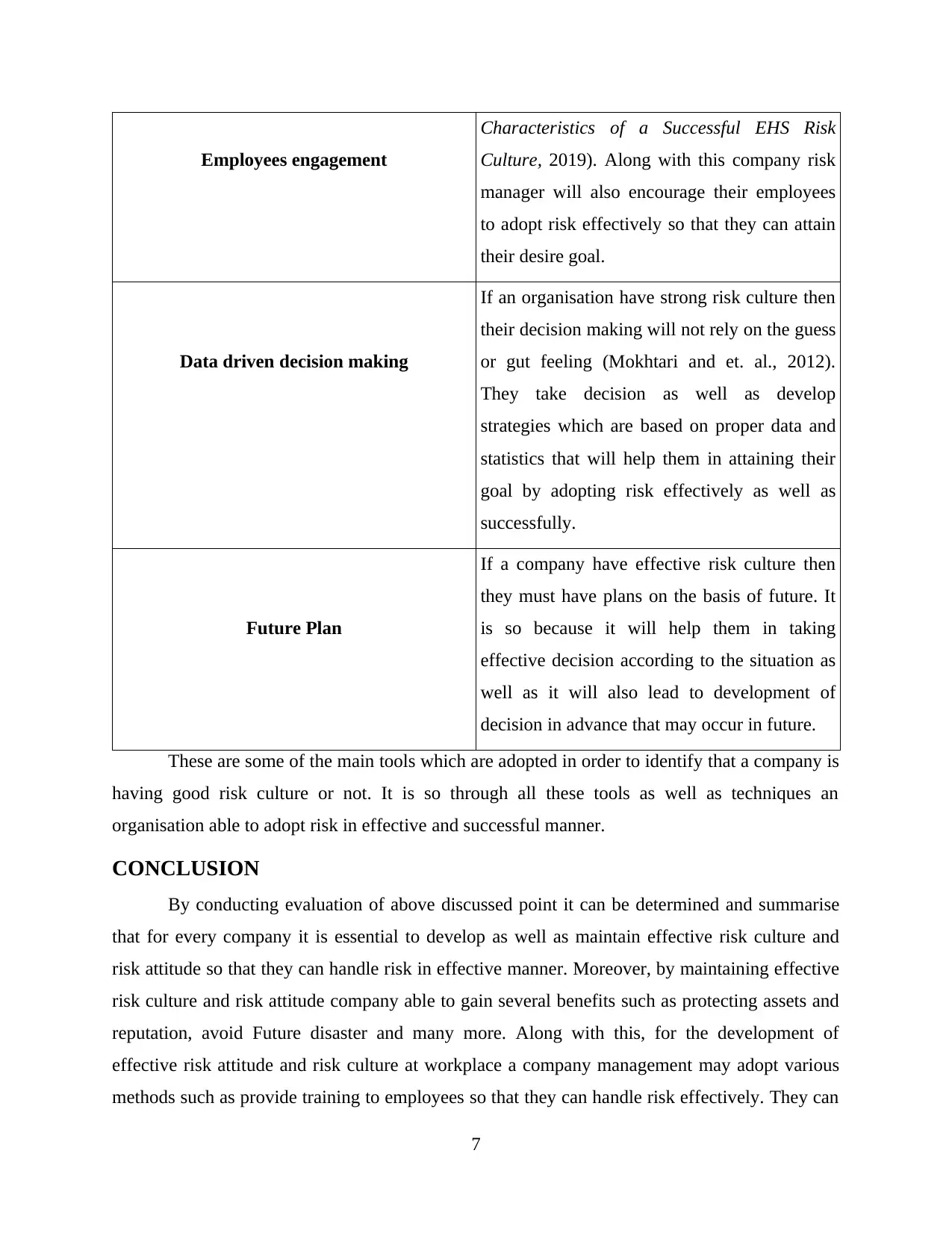
Employees engagement
Characteristics of a Successful EHS Risk
Culture, 2019). Along with this company risk
manager will also encourage their employees
to adopt risk effectively so that they can attain
their desire goal.
Data driven decision making
If an organisation have strong risk culture then
their decision making will not rely on the guess
or gut feeling (Mokhtari and et. al., 2012).
They take decision as well as develop
strategies which are based on proper data and
statistics that will help them in attaining their
goal by adopting risk effectively as well as
successfully.
Future Plan
If a company have effective risk culture then
they must have plans on the basis of future. It
is so because it will help them in taking
effective decision according to the situation as
well as it will also lead to development of
decision in advance that may occur in future.
These are some of the main tools which are adopted in order to identify that a company is
having good risk culture or not. It is so through all these tools as well as techniques an
organisation able to adopt risk in effective and successful manner.
CONCLUSION
By conducting evaluation of above discussed point it can be determined and summarise
that for every company it is essential to develop as well as maintain effective risk culture and
risk attitude so that they can handle risk in effective manner. Moreover, by maintaining effective
risk culture and risk attitude company able to gain several benefits such as protecting assets and
reputation, avoid Future disaster and many more. Along with this, for the development of
effective risk attitude and risk culture at workplace a company management may adopt various
methods such as provide training to employees so that they can handle risk effectively. They can
7
Characteristics of a Successful EHS Risk
Culture, 2019). Along with this company risk
manager will also encourage their employees
to adopt risk effectively so that they can attain
their desire goal.
Data driven decision making
If an organisation have strong risk culture then
their decision making will not rely on the guess
or gut feeling (Mokhtari and et. al., 2012).
They take decision as well as develop
strategies which are based on proper data and
statistics that will help them in attaining their
goal by adopting risk effectively as well as
successfully.
Future Plan
If a company have effective risk culture then
they must have plans on the basis of future. It
is so because it will help them in taking
effective decision according to the situation as
well as it will also lead to development of
decision in advance that may occur in future.
These are some of the main tools which are adopted in order to identify that a company is
having good risk culture or not. It is so through all these tools as well as techniques an
organisation able to adopt risk in effective and successful manner.
CONCLUSION
By conducting evaluation of above discussed point it can be determined and summarise
that for every company it is essential to develop as well as maintain effective risk culture and
risk attitude so that they can handle risk in effective manner. Moreover, by maintaining effective
risk culture and risk attitude company able to gain several benefits such as protecting assets and
reputation, avoid Future disaster and many more. Along with this, for the development of
effective risk attitude and risk culture at workplace a company management may adopt various
methods such as provide training to employees so that they can handle risk effectively. They can
7
Paraphrase This Document
Need a fresh take? Get an instant paraphrase of this document with our AI Paraphraser
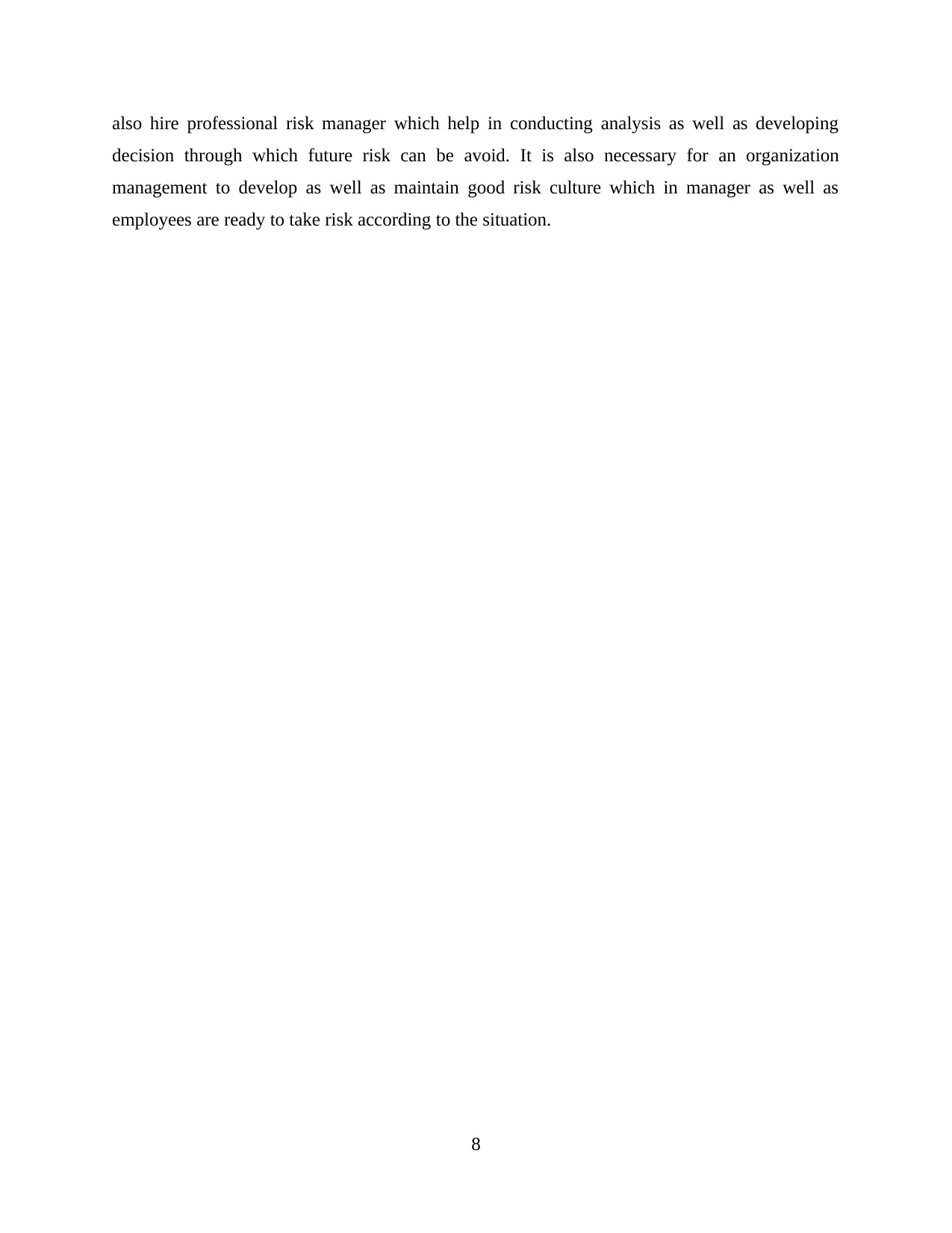
also hire professional risk manager which help in conducting analysis as well as developing
decision through which future risk can be avoid. It is also necessary for an organization
management to develop as well as maintain good risk culture which in manager as well as
employees are ready to take risk according to the situation.
8
decision through which future risk can be avoid. It is also necessary for an organization
management to develop as well as maintain good risk culture which in manager as well as
employees are ready to take risk according to the situation.
8
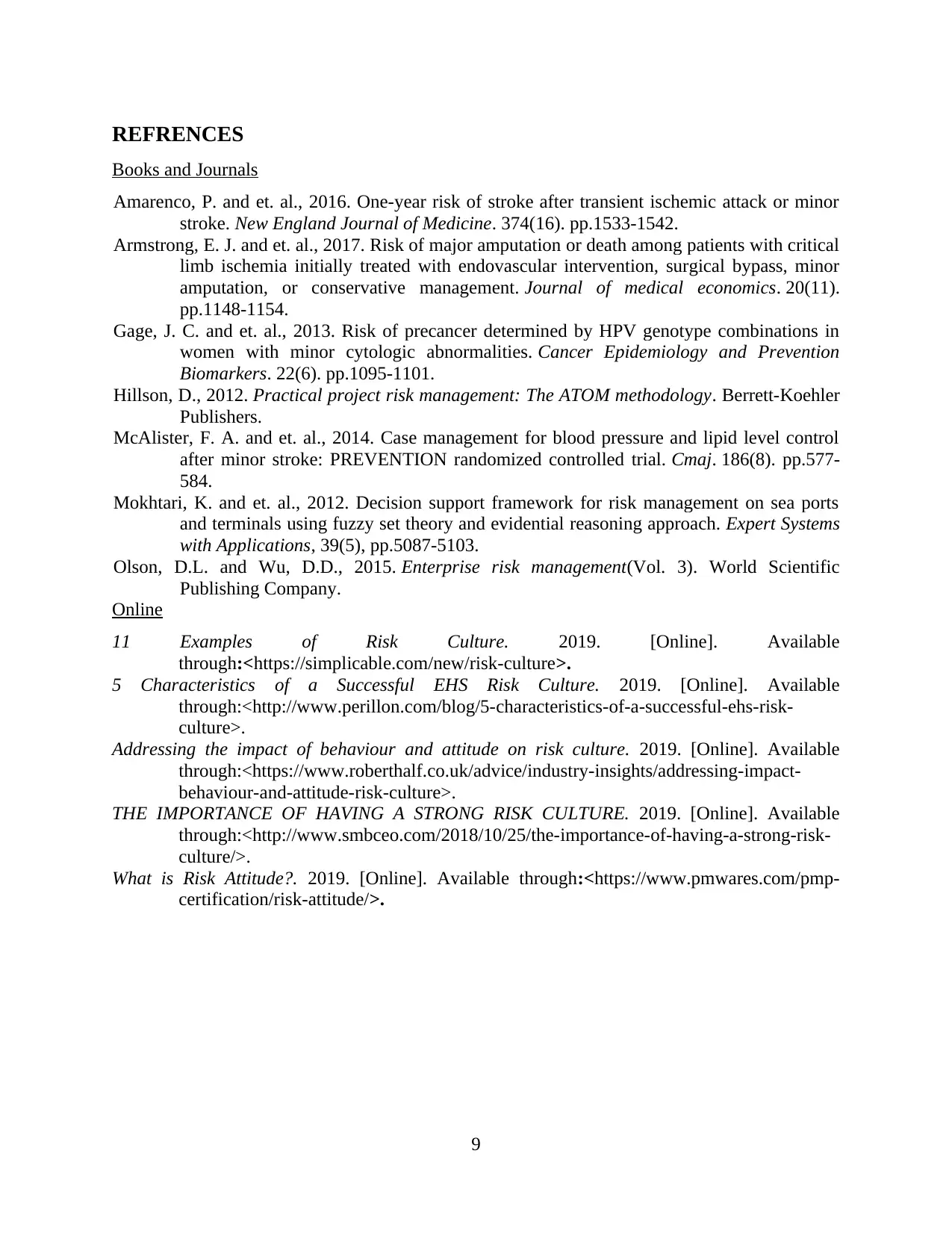
REFRENCES
Books and Journals
Amarenco, P. and et. al., 2016. One-year risk of stroke after transient ischemic attack or minor
stroke. New England Journal of Medicine. 374(16). pp.1533-1542.
Armstrong, E. J. and et. al., 2017. Risk of major amputation or death among patients with critical
limb ischemia initially treated with endovascular intervention, surgical bypass, minor
amputation, or conservative management. Journal of medical economics. 20(11).
pp.1148-1154.
Gage, J. C. and et. al., 2013. Risk of precancer determined by HPV genotype combinations in
women with minor cytologic abnormalities. Cancer Epidemiology and Prevention
Biomarkers. 22(6). pp.1095-1101.
Hillson, D., 2012. Practical project risk management: The ATOM methodology. Berrett-Koehler
Publishers.
McAlister, F. A. and et. al., 2014. Case management for blood pressure and lipid level control
after minor stroke: PREVENTION randomized controlled trial. Cmaj. 186(8). pp.577-
584.
Mokhtari, K. and et. al., 2012. Decision support framework for risk management on sea ports
and terminals using fuzzy set theory and evidential reasoning approach. Expert Systems
with Applications, 39(5), pp.5087-5103.
Olson, D.L. and Wu, D.D., 2015. Enterprise risk management(Vol. 3). World Scientific
Publishing Company.
Online
11 Examples of Risk Culture. 2019. [Online]. Available
through:<https://simplicable.com/new/risk-culture>.
5 Characteristics of a Successful EHS Risk Culture. 2019. [Online]. Available
through:<http://www.perillon.com/blog/5-characteristics-of-a-successful-ehs-risk-
culture>.
Addressing the impact of behaviour and attitude on risk culture. 2019. [Online]. Available
through:<https://www.roberthalf.co.uk/advice/industry-insights/addressing-impact-
behaviour-and-attitude-risk-culture>.
THE IMPORTANCE OF HAVING A STRONG RISK CULTURE. 2019. [Online]. Available
through:<http://www.smbceo.com/2018/10/25/the-importance-of-having-a-strong-risk-
culture/>.
What is Risk Attitude?. 2019. [Online]. Available through:<https://www.pmwares.com/pmp-
certification/risk-attitude/>.
9
Books and Journals
Amarenco, P. and et. al., 2016. One-year risk of stroke after transient ischemic attack or minor
stroke. New England Journal of Medicine. 374(16). pp.1533-1542.
Armstrong, E. J. and et. al., 2017. Risk of major amputation or death among patients with critical
limb ischemia initially treated with endovascular intervention, surgical bypass, minor
amputation, or conservative management. Journal of medical economics. 20(11).
pp.1148-1154.
Gage, J. C. and et. al., 2013. Risk of precancer determined by HPV genotype combinations in
women with minor cytologic abnormalities. Cancer Epidemiology and Prevention
Biomarkers. 22(6). pp.1095-1101.
Hillson, D., 2012. Practical project risk management: The ATOM methodology. Berrett-Koehler
Publishers.
McAlister, F. A. and et. al., 2014. Case management for blood pressure and lipid level control
after minor stroke: PREVENTION randomized controlled trial. Cmaj. 186(8). pp.577-
584.
Mokhtari, K. and et. al., 2012. Decision support framework for risk management on sea ports
and terminals using fuzzy set theory and evidential reasoning approach. Expert Systems
with Applications, 39(5), pp.5087-5103.
Olson, D.L. and Wu, D.D., 2015. Enterprise risk management(Vol. 3). World Scientific
Publishing Company.
Online
11 Examples of Risk Culture. 2019. [Online]. Available
through:<https://simplicable.com/new/risk-culture>.
5 Characteristics of a Successful EHS Risk Culture. 2019. [Online]. Available
through:<http://www.perillon.com/blog/5-characteristics-of-a-successful-ehs-risk-
culture>.
Addressing the impact of behaviour and attitude on risk culture. 2019. [Online]. Available
through:<https://www.roberthalf.co.uk/advice/industry-insights/addressing-impact-
behaviour-and-attitude-risk-culture>.
THE IMPORTANCE OF HAVING A STRONG RISK CULTURE. 2019. [Online]. Available
through:<http://www.smbceo.com/2018/10/25/the-importance-of-having-a-strong-risk-
culture/>.
What is Risk Attitude?. 2019. [Online]. Available through:<https://www.pmwares.com/pmp-
certification/risk-attitude/>.
9
⊘ This is a preview!⊘
Do you want full access?
Subscribe today to unlock all pages.

Trusted by 1+ million students worldwide
1 out of 12
Related Documents
Your All-in-One AI-Powered Toolkit for Academic Success.
+13062052269
info@desklib.com
Available 24*7 on WhatsApp / Email
![[object Object]](/_next/static/media/star-bottom.7253800d.svg)
Unlock your academic potential
Copyright © 2020–2025 A2Z Services. All Rights Reserved. Developed and managed by ZUCOL.




